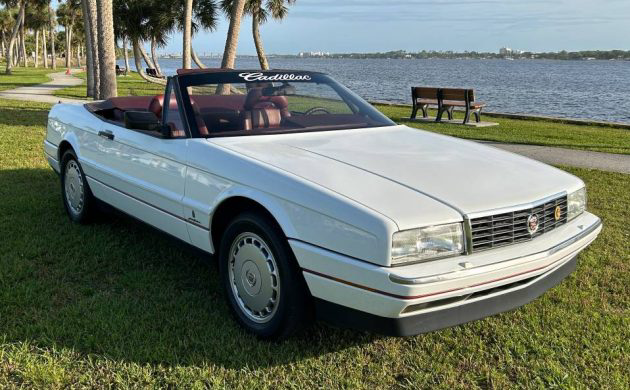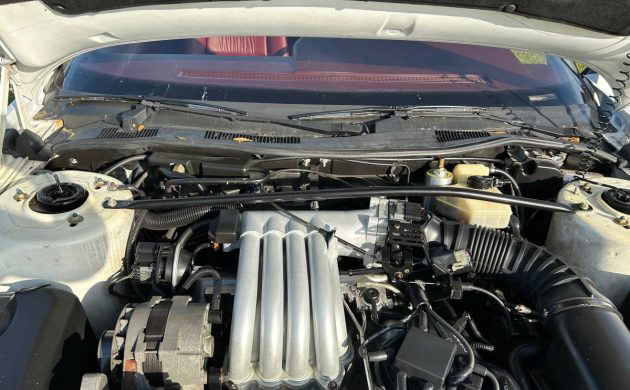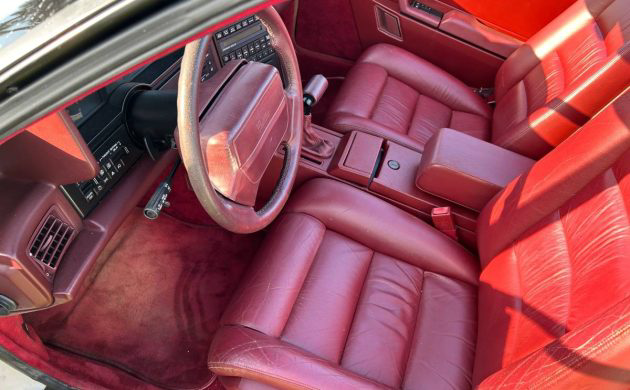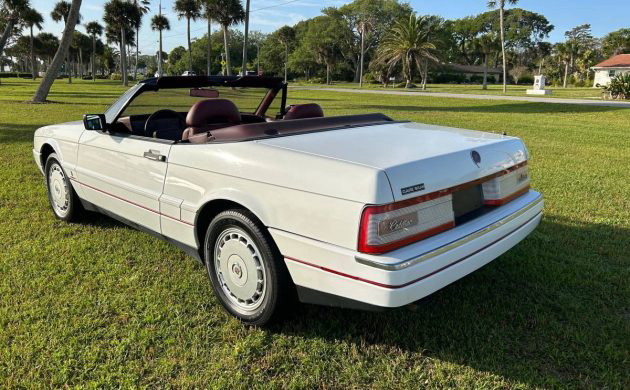Spurning its own internal design team in favor of Pininfarina, and electing a demonstrably expensive assembly process involving two continents and a jumbo jet, Cadillac launched the Allanté for model year 1987. The two-seat roadster arrived with an underpowered engine contradicted by a very high price, equivalent to $146k today. Even so, no power top was available until late 1990. Credit where credit is due, however: Cadillac continually refined the car through its seven year history, mostly for the better. Randy Johnson found this Pearl White example for us, advertised here on craigslist for $9900 in Ormond Beach, Florida; it is nearly flawless and runs and drives well. Thanks, Randy!
The Allanté traveled a tortuous route to its buyer’s garage: Cadillac shipped Eldorado chassis via Boeing 747 – fifty-six at a time – to a purpose-built factory in Italy where Pininfarina shortened said chassis and installed the steel and aluminum body. In turn, these assemblies were jetted back to Detroit where the mechanicals were installed – rinse and repeat until some 21,430 were made. The car was configured with front wheel drive and powered by a V8 engine. The first of these was Cadillac’s 4.1 liter, rated at only 170 hp and less than reliable on the road. By 1989, Cadillac had graduated the Allanté to a 4.5 liter V8 generating 200 hp – just about enough. (For 1993, Cadillac introduced its Northstar engine, with more power. These last-year cars stand above earlier Allantés, both in terms of performance and value.) Gearshifts are courtesy of a four-speed automatic. Speed-sensing suspension, variable-assist power steering, and traction control were just a few of the car’s technological marvels. This one’s engine bay reveals only a hint of its 49,875 mile odometer reading.
The interior is saturated with space-age controls – more than 50 buttons and switches are at hand to confuse the driver. The dash is digital as is the “driver information center”, which in this example has gone dark. The radio still works, however. These digital modules are difficult to repair – just one of the voids when it comes to parts and restoration help for this orphan model. The lush leather seats are from Recaro – an eminent name but drivers report that during long trips, their hard surfaces become uncomfortable. Only slight wear is discernable on the driver’s seat, and the trunk is very tidy.
The slightly severe lines don’t radiate the best of Pininfarina. To be kind, we can call the styling “understated elegance”. The market is doubtful of the car’s appeal as well. Notwithstanding the expensiveness of the Allanté upon its introduction and the relatively low production, these cars have not gained much notice from collectors as yet. Pre-1993 cars will sell in the mid four figures to low five figures. Those ’93 cars are lurching towards $30k. If an Allanté is on your bucket list, best to spring for the finest example you can afford.






As soon as I saw “Cadillac”, I knew it was front wheel drive.
Why would you make a 2 seater roadster, a Front wheel drive Hairdresser’s car?
The corvette isn’t front wheel drive!!!!
The Eldorado/Riviera/Tornado chasis was the best suited platform at GM. With excellent chasis tuning, the Allante has surprisingly responsive handling
Some say they should have used the Camaro, but for NVH? Forget it. And when the successor used a Corvette platform, Cadillac owners stayed away in droves. The XLR sold a fraction of the Allanté’s figures.
Supposedly, Pininfarina was the biggest fan of the FWD platform, and while the car is less “sports car like” than an R107, it is much, much roomier, and far more practical, with a huge trunk that will fit your ski gear, bikes, etc, inside.
This car was designed for Cadillac buyers, not for gymkannas.
As for the Italian assembly: In 1982 when the design was locked in and the contracts signed, the dollar had soared to 10 french francs or 4 Deutch Marks (there was no Euro) and it was cheaper to build the car in Turin than in North America, especially as GM did not have a suitable factory for a low-volume car built to higher tolerances than standard Cadillacs. Unfortunately, in ’85-’86, the dollar crashed back to earth, eliminating that cost advantage, making the car much more expensive to make than planned, and limiting GM’s pricing power on them..
Pininfarina dithered, too. The car was a year late, with a leaking convertible top, and the Stock Market crash of 1987 pummelled GM sales, especially for a new, high end product
I have had one for four years. The seats are the most comfortable I have experienced in any car, and I’ve never heard anyone complain that they get “hard,” although the buttery Poltrona-Frau leather will harden if not regularly treated. If they made a new model, I would buy it today
I had a 93 Northstar and it was a powerful FWD car.
Once things started breaking, it ate a hole through my wallet.
These are not $30,000 cars.
I don’t know of any current European luxury car that will not eat several holes in your wallet, duffel bag, or steamer trunch once the lease period has elapsed.
Not a European car, except for the body panels, interior, and tops. The rest is GM Eldorado, all mechanical parts seem to be avaiable from major auto suppliers, and Avante-only parts from three guys, one in San Diego, one just outside Camden NJ and one in FL, I have delt with the first two, very satisfactorily.
And they all leak oil especially the northstar engines
Totally CADILLACKING! Another step in the wrong direction knocking Cadillac from its lofty Standard of the WORLD.
Let’s see, Cimarron, Allante, Catera..then GM had the temerity to dump Oldsmobile instead?
Another classic case of GM introducing a car with a lot of problems, they fix them over a few years until they are quite decent, then they axe the model. The Chevy Citation, Pontiac Fiero , Buick Riatta also come to mind, along with the 350 diesel engine. Once GM fixed its problems it too went the way of the dodo.
So, out of curiousity, and your opinion, what was wrong with the Chevy Citation. 20 some years ago I bought my late girlfriend a nice used one with 100k plus miles. She had it many years and no major troubles. I did not like the stupid vertically mounter radio. Finally she sold it and bought a beautiful 85 Seville.
I had a Pontiac Phoenix, with the I 4. At 130,000 it went to junk yard, steering rack toast, ball joints toast, not gutless but not very powerful, downshift on Maine Turnpike when fully loaded with 5 of us – but it did fit 3 teenagers in the back seat – hatchback was good but prop rods failed at about 60,000 miles, went to dealership to buy new ones, parts guy would not sell them to me, started yelling, using the F word (no customers were around) service manager came out, owner who was a very good guy, and a very important person in politics, came out, owner told parts guy to sell them to me, had my 14 year old son with me, went out, opened the hatch, took out the old ones, put in the new ones, waved to the assembled crowd in the doorway, waved and drove off. Never went back. Death came when son slid into utlitiy pole on ice, still drove, took him out at night to drive in parking lot on ice, distributor shaft broke, given all the issues, plus rust, that was the end. One of the very few cars I have had that did not go more than 200,000 miles, including 4 Dodge Caravans, a Saab, a Caddy Cimmaron, a Pontiac Bonneville wagon with the 400 cu engine, a Ford Ranch wagon with the 302, most died of rust, and a ’56 Chevy Powerglide 6 that would have if my sister had not driven it at 70mph on the Mass Pike down 3 quarts of oil.
While sales were certainly disappointing, about 60% of projections, development improved them significantly, and a ’94 model with a full power top was ready to go when GM managment killed it……..along with the Fiero (new model was ready to go) and the Reatta, because with GM’s stock price battered, the accounants on the 27th floor eliminated a rounding error…..and most of GM’s interesting specialty products in one fell swoop.
Wasn’t most of the Citation’s platform recycled into the Celebrity?
Even the ’93’s with low (say 50,000 miles) milage, in great condition, are selling for $10,000 to $12,000. We, owners, hope for the day when they are worth $30,000! These are a great way into the hobby, they are toys, like my buddy’s Ferrari, they are not practical for long distances, and unlike the Ferrari they are not sports cars for competitions. They are great weekend, not too long distance drivers, to cars and coffees, grocery store. They handle very well, the ’93’s with regular El Dorado seats, are more comfortable than the Recaros of earlier years, the speed and tilt sensitive rear suspension, the transmission, are all good. The wind noise, top down, soft top up, hard top on, is too much at 75 mph to be tolerable for my wife to ride in it, let alone drive it. But, mine has 140,000 miles and goes strong. This one looks a lot better than mine, I am missing a couple pieces of little trim, rear plastic over light assembly is scratched, radio has been replaced by a unit in the trunk (with CD player and remote control), rust over one rear wheel well, but it is fast and goes around corners like on tracks. Northstar V8 is well, probably because it has had oil changes religously.
I want Kelly Bundy to try and convince me to buy this car. She does have a way of swaying buyers.
Can you imagine what a 1985 Cadillac El Dorado Biarritz cov would be worth if it were RWD? Some of the finest car from GM were ruined by FWD and this is one of them.
A ’93 Allante is on my bucket list. As is a ’04 XLR. Yes, they are not land yachts but “sporty” Cadillacs that I’ve never had the pleasure of driving or owning.
We’ll see if I live long enough to enjoy them. Or curse them.
Plus, I wouldn’t trust any car out of Florida or North Carolina.